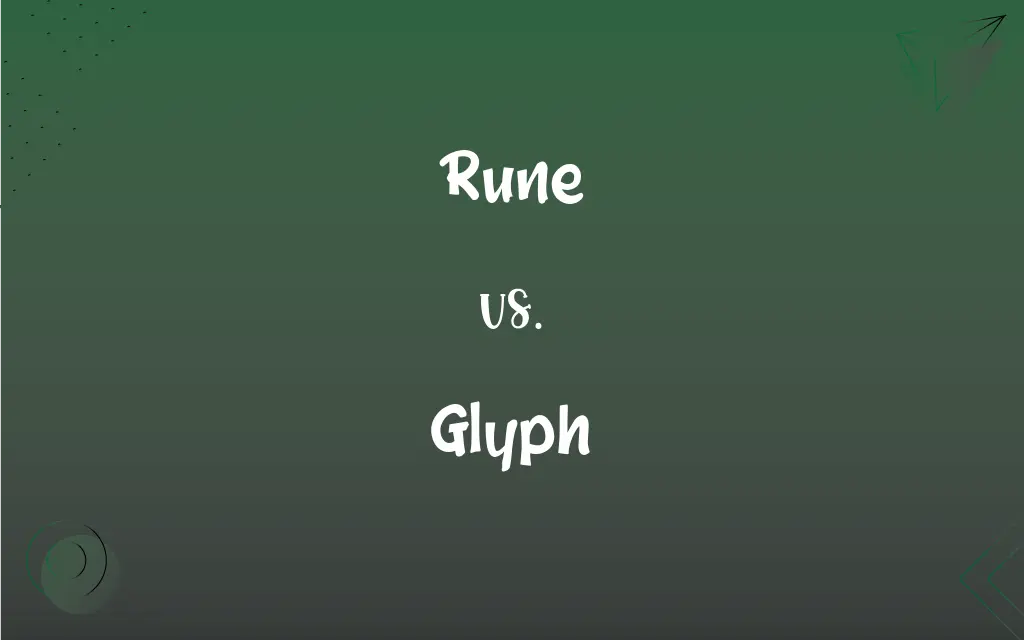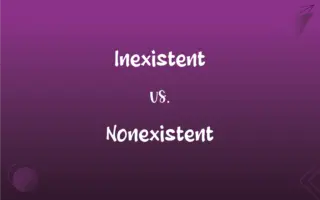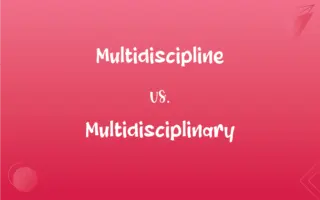Rune vs. Glyph: What's the Difference?
Edited by Aimie Carlson || By Janet White || Updated on October 12, 2023
Rune is a character from ancient Germanic alphabets, while Glyph is a symbol conveying information non-phonetically.

Key Differences
Rune references characters that belong to a set of alphabets used by ancient Germanic peoples, including the Norse. Glyph, however, pertains to a symbolic figure or character used in art or writing, representing more than just phonetic sounds.
Historically, Runes were not just letters but were also believed to possess mystical properties. People often used them in rituals or as charms. On the other hand, a Glyph can be any design representing an idea, character, or symbol, without being confined to any specific culture or belief.
The origins of Runes can be traced back to Northern Europe and are deeply rooted in the Norse and Germanic histories. In contrast, Glyphs are universal and can be found in numerous cultures worldwide, like the hieroglyphs of ancient Egypt or the intricate glyphs in Mayan script.
Runes are often associated with specific sounds or words in the Germanic languages, allowing for written communication. However, a Glyph might be more abstract, not always directly tied to phonetics, and may represent a whole word, concept, or a part of a word.
Both Runes and Glyphs offer insights into the cultures they originate from. Runes provide a window into ancient European pagan beliefs and practices, while Glyphs, depending on their source, can offer vast knowledge, ranging from ancient religious practices to linguistic nuances.
ADVERTISEMENT
Comparison Chart
Definition
Character from ancient Germanic alphabets
Symbol conveying information non-phonetically
Cultural Association
Germanic and Norse
Universal across various cultures
Primary Use
Written communication, rituals
Convey ideas, symbols in art or writing
Phonetics
Associated with specific sounds/words
Not always tied to phonetic sounds
Historical Significance
Tied to pagan beliefs and practices
Varies based on culture and script
ADVERTISEMENT
Rune and Glyph Definitions
Rune
A character from an ancient Germanic alphabet.
The Viking inscribed a rune on the stone.
Glyph
A character that represents a word, idea, or part of a word.
The hieroglyphic script is made up of numerous glyphs.
Rune
An inscription using ancient Germanic characters.
Archaeologists discovered runes in the old burial site.
Glyph
An ornamental carving or design.
The glyph on the pottery tells a story of harvest.
Rune
A mark or letter believed to have mystical powers.
She wore a pendant with a protective rune.
Glyph
A symbolic figure in writing or art.
The ancient temple wall was adorned with intricate glyphs.
Rune
A token or charm with inscribed symbols.
The warrior carried a rune for good luck in battle.
Glyph
A non-phonetic symbol in a writing system.
The dollar sign ($) is a glyph representing currency.
Rune
Any of the characters in several alphabets used by ancient Germanic peoples from the 3rd to the 13th century.
Glyph
A specific shape of a character in typography.
The typeface had a unique glyph for the letter A.
Rune
A similar character in another alphabet, sometimes believed to have magic powers.
Glyph
(Architecture)A vertical groove, especially in a Doric column or frieze.
Rune
A poem or incantation of mysterious significance, especially a magic charm.
Glyph
A symbolic figure that is usually engraved or incised.
Rune
A Finnish poem or section of a poem.
Glyph
A symbol, such as a stylized figure or arrow on a public sign, that imparts information nonverbally.
Rune
A letter, or character, used in the written language of various ancient Germanic peoples, especially the Scandinavians and the Anglo-Saxons.
Glyph
A figure carved in relief or incised, especially representing a sound, word, or idea.
Rune
A Finnish or Scandinavian epic poem, or a division of one, especially a division of the Kalevala.
Glyph
Any of various figures used in Mayan writing.
Rune
A letter or mark used as a mystical or magic symbol.
Glyph
Any non-verbal symbol that imparts information.
Rune
A verse or song, especially one with mystical or mysterious overtones; a spell or an incantation.
Glyph
A visual representation of a letter, character, or symbol, in a specific font and style.
Rune
(obsolete) secret or mystery.
Glyph
(architectural element) A vertical groove.
Rune
A Unicode code point.
Glyph
A sunken channel or groove, usually vertical. See Triglyph.
Rune
A letter, or character, belonging to the written language of the ancient Norsemen, or Scandinavians; in a wider sense, applied to the letters of the ancient nations of Northern Europe in general.
Glyph
A carved figure or character, incised or in relief; a carved pictograph; hence, a pictograph representing a form originally adopted for sculpture, whether carved or painted.
Rune
Old Norse poetry expressed in runes.
Runes were upon his tongue,As on the warrior's sword.
Glyph
Glyptic art in the form of a symbolic figure carved or incised in relief
Rune
Any character from an ancient Germanic alphabet used in Scandinavia from the 3rd century to the Middle Ages;
Each rune had its own magical significance
Rune
A symbol in a system of writing.
The rune stood for both a sound and a concept in their language.
FAQs
Can Glyphs be found in various cultures?
Yes, glyphs are universal and can be found in many cultures worldwide.
What sound does a Rune represent?
Runes are associated with specific sounds or words in the Germanic languages.
Can a Glyph represent an entire word?
Yes, a glyph can represent an entire word, a concept, or a part of a word.
Is a hieroglyph a type of Glyph?
Yes, hieroglyphs are a form of glyphs used in ancient Egyptian script.
Can a Rune be used as a charm or amulet?
Historically, runes were engraved on objects and used as charms or amulets for protection or luck.
Is the origin of Runes primarily Northern European?
Yes, runes have their origins in Northern Europe, especially within Norse and Germanic cultures.
Is every letter in typography a Glyph?
Yes, in typography, each specific shape or design of a letter is considered a glyph.
Do Runes have mystical or ritualistic connotations?
Historically, runes were believed to possess mystical properties and were used in rituals.
What is a Rune primarily associated with?
A rune is primarily associated with ancient Germanic alphabets.
Were Runes only used for writing?
While runes were used for writing, they were also used in rituals and believed to have magical properties.
Do all writing systems contain Glyphs?
Most writing systems contain glyphs, which are characters or symbols representing sounds, ideas, or words.
Can Runes be found in modern pop culture?
Yes, runes often appear in modern pop culture, especially in contexts related to fantasy or historical fiction.
Are Glyphs restricted to religious texts?
No, glyphs are not restricted to religious texts; they appear in various writing systems and art forms.
Do people today wear jewelry with Runes?
Yes, some people wear jewelry with runes, often for their symbolic or aesthetic value.
Are Runes still in use today?
While runes are not commonly used for communication today, they are studied for historical and cultural insights and can be found in some modern symbolic contexts.
Can a Glyph be abstract?
Yes, a glyph can be abstract, representing an idea or concept without a direct phonetic tie.
Is every Glyph related to ancient cultures?
No, while many glyphs have ancient origins, they can also be part of modern writing systems or designs.
Can a Glyph be an ornamental design?
Yes, a glyph can be an ornamental design or carving, conveying symbolic information.
Are all Glyphs associated with religious or mystical practices?
No, while some glyphs have religious or mystical significance, others are simply symbols in a writing system.
How do Runes and Glyphs relate to linguistics?
Both runes and glyphs offer insights into the evolution of languages, communication methods, and the cultures they originate from.
About Author
Written by
Janet WhiteJanet White has been an esteemed writer and blogger for Difference Wiki. Holding a Master's degree in Science and Medical Journalism from the prestigious Boston University, she has consistently demonstrated her expertise and passion for her field. When she's not immersed in her work, Janet relishes her time exercising, delving into a good book, and cherishing moments with friends and family.
Edited by
Aimie CarlsonAimie Carlson, holding a master's degree in English literature, is a fervent English language enthusiast. She lends her writing talents to Difference Wiki, a prominent website that specializes in comparisons, offering readers insightful analyses that both captivate and inform.































































